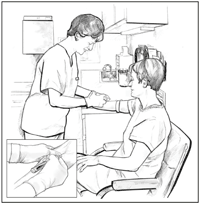What I need to know about Celiac Disease
On this page:
What is celiac disease?
Having celiac disease means a person can’t eat gluten, a protein found in wheat, rye, or barley. Gluten may also be found in some medicines. Celiac disease is hereditary, meaning it runs in families. The treatment for celiac disease is a gluten-free diet. Other names for celiac disease are celiac sprue and gluten intolerance.
In people with celiac disease, the body’s immune system responds to gluten by damaging the lining of the small intestine. This lining has small finger-like growths called villi. The villi normally absorb nutrients from the foods we eat. When the villi are damaged, the body can’t get the nutrients it needs.
People with celiac disease don’t always know they have it because they don’t feel sick. Or if they feel sick, they don’t know celiac disease is the cause.
[Top]
Is celiac disease serious?
Yes. Celiac disease can be very serious. Besides stomach pain, it can cause anemia, malnutrition, infertility, a certain skin rash, and other health problems.
[Top]
What are the symptoms of celiac disease?
Symptoms of celiac disease include
- gas
- diarrhea
- stomach pain
- feeling very tired
- change in mood
- weight loss
- a very itchy skin rash with blisters
- slowed growth
Most people with celiac disease have one or more symptoms, but not all have digestive problems. And some people with the disease don’t have any symptoms. Having one or more of these symptoms does not mean a person has celiac disease because many other disorders include these symptoms.
[Top]
How is celiac disease diagnosed?
Celiac disease can be hard to discover because its symptoms are like many other digestive diseases. People with celiac disease can go untreated for many years.
If your doctor thinks you have celiac disease, you will probably need a blood test. You will need to follow your regular diet before and while being tested. If you don’t, the results could be wrong.

If your test results show you might have celiac disease, the doctor will perform a biopsy to make sure celiac disease is the problem. For a biopsy, the doctor takes a small piece of tissue from your small intestine. To get to your small intestine, the doctor puts a long tube into your mouth and down into your stomach. At the end of the tube are small tools for snipping out the bit of tissue needed to view with a microscope. You will take medicine before the biopsy that makes you very sleepy. It also keeps you from feeling any pain. Many people sleep through the procedure.
[Top]
How is celiac disease treated?
The only treatment for celiac disease is a gluten-free diet. A dietitian can work with you to help you learn how to select gluten-free foods. A dietitian is an expert in food and healthy eating. You will learn to check labels of foods and other items for gluten. If you eliminate gluten from your diet, your small intestine will heal. If you eat gluten, or use items that contain gluten, you will harm your small intestine.
The following chart lists examples of foods you can eat and foods you should stay away from if you have celiac disease. This list is not complete. A dietitian can help you learn what other foods you can and can’t eat when following a gluten-free diet.

| Allowed Foods |
Amaranth
Arrowroot
Buckwheat
Cassava
Corn
Flax
Indian rice grass
Job’s tears
Legumes
Millet
Nuts |
Potatoes
Quinoa
Rice
Sago
Seeds
Soy
Sorghum
Tapioca
Wild Rice
Yucca |
| Foods To Avoid |
Wheat
- Including einkorn, emmer, spelt, kamut
- Wheat starch, wheat bran, wheat germ, cracked wheat, hydrolyzed wheat protein
|
Barley
Rye
Triticale (a cross between wheat and rye) |
| Other Wheat Products |
Bromated flour
Durum flour
Enriched flour
Farina
Graham flour |
Phosphated flour
Plain flour
Self-rising flour
Semolina
White flour |
| Processed Foods that May Contain Wheat, Barley, or Rye* |
Bouillon cubes
Brown rice syrup
Chips/potato chips
Candy
Cold cuts, hot dogs, salami, sausage
Communion wafer
French fries
Gravy |
Imitation fish
Matzo
Rice mixes
Sauces
Seasoned tortilla chips
Self-basting turkey
Soups
Soy sauce
Vegetables in sauce |
| * Most of these foods can be found gluten-free. When in doubt, check with the food manufacturer. |
From the following resource: Thompson T. Celiac Disease Nutrition Guide, 2nd ed. Chicago: American Dietetic Association; 2006. © American Dietetic Association. Adapted with permission. For a complete copy of the Celiac Disease Nutrition Guide, please visit www.eatright.org.
[Top]
Points to Remember
- People with celiac disease can’t eat foods or use items with gluten in them.
- Celiac disease harms the small intestine.
- People with untreated celiac disease can’t get needed nutrients.
- Without treatment, people with celiac disease can develop other health problems.
- Celiac disease is diagnosed by blood tests and a biopsy of the small intestine.
- A gluten-free diet must be followed for life.
- A dietitian can help people choose the right foods.
[Top]
Pronunciation Guide
celiac disease (SEE-lee-ak) (dih-ZEEZ)
dietitian (dy-uh-TISH-uhn)
gluten (GLOO-tuhn)
small intestine (in-TESS-tin)
[Top]
The U.S. Government does not endorse or favor any specific commercial product or company. Trade, proprietary, or company names appearing in this document are used only because they are considered necessary in the context of the information provided. If a product is not mentioned, the omission does not mean or imply that the product is unsatisfactory.
For More Information
Celiac Disease Awareness Campaign
National Digestive Diseases Information Clearinghouse
2 Information Way
Bethesda, MD 20892–3570
Phone: 1–800–891–5389
Fax: 703–738–4929
Email: celiac@info.niddk.nih.gov
Internet: www.celiac.nih.gov
American Celiac Society
P.O. Box 23455
New Orleans, LA 70183–0455
Phone: 504–737–3293
Email: info@americanceliacsociety.org
Internet: www.americanceliacsociety.org
American Dietetic Association
120 South Riverside Plaza, Suite 2000
Chicago, IL 60606–6995
Phone: 1–800–877–1600
Email: knowledge@eatright.org
Internet: www.eatright.org
Celiac Disease Foundation
13251 Ventura Boulevard, #1
Studio City, CA 91604
Phone: 818–990–2354
Fax: 818–990–2379
Email: cdf@celiac.org
Internet: www.celiac.org
Celiac Sprue Association/USA Inc.
P.O. Box 31700
Omaha, NE 68131–0700
Phone: 1–877–CSA–4CSA (272–4272)
Fax: 402–558–1347
Email: celiacs@csaceliacs.org
Internet: www.csaceliacs.org
Gluten Intolerance Group of North America
31214 124th Avenue SE
Auburn, WA 98092
Phone: 253–833–6655
Fax: 253–833–6675
Email: info@gluten.net
Internet: www.gluten.net
National Foundation for Celiac Awareness
P.O. Box 544
Ambler, PA 19002
Phone: 215–325–1306
Email: info@celiaccentral.org
Internet: www.celiaccentral.org
[Top]
Acknowledgments
The National Digestive Diseases Information Clearinghouse (NDDIC) would like to thank William F. Stenson, M.D., Washington University, for assisting with the scientific and editorial review of this publication. Thanks also to Alice Bast and Nancy Dickens, National Foundation for Celiac Awareness; Cynthia Kupper, R.D., C.D., Gluten Intolerance Group; and Elaine Monarch, Celiac Disease Foundation, for reviewing the food chart.
Thank you also to Joseph Murray, M.D., at the Mayo Clinic College of Medicine, Rochester, MN, for facilitating field-testing of this publication.
[Top]
The Celiac Disease Awareness Campaign
To meet the need for comprehensive and current information about celiac disease, the National Digestive Diseases Information Clearinghouse (NDDIC), a service of the National Institute of Diabetes and Digestive and Kidney Diseases (NIDDK), launched the Celiac Disease Awareness Campaign. The Awareness Campaign is the result of the combined ideas and efforts of the professional and voluntary organizations that focus on celiac disease, along with the NIDDK, the National Institutes of Health, and the Centers for Disease Control and Prevention.
Visit www.celiac.nih.gov to learn more about the Awareness Campaign.

This publication may contain information about medications used to treat a health condition. When this publication was prepared, the NIDDK included the most current information available Occasionally, new information about medication is released. For updates or for questions about any medications, please contact the U.S. Food and Drug Administration at 1–888–INFO–FDA (463–6332), a toll-free call, or visit their website at www.fda.gov. Consult your doctor for more information.
[Top]
National Digestive Diseases Information Clearinghouse
2 Information Way
Bethesda, MD 20892–3570
Phone: 1–800–891–5389
TTY: 1–866–569–1162
Fax: 703–738–4929
Email: nddic@info.niddk.nih.gov
Internet: www.digestive.niddk.nih.gov
The National Digestive Diseases Information Clearinghouse (NDDIC) is a service of the National Institute of Diabetes and Digestive and Kidney Diseases (NIDDK). The NIDDK is part of the National Institutes of Health of the U.S. Department of Health and Human Services. Established in 1980, the Clearinghouse provides information about digestive diseases to people with digestive disorders and to their families, health care professionals, and the public. The NDDIC answers inquiries, develops and distributes publications, and works closely with professional and patient organizations and Government agencies to coordinate resources about digestive diseases.
Publications produced by the Clearinghouse are carefully reviewed by both NIDDK scientists and outside experts.
This publication is not copyrighted. The Clearinghouse encourages users of this publication to duplicate and distribute as many copies as desired.
NIH Publication No. 07–5755
August 2007
[Top]
|




